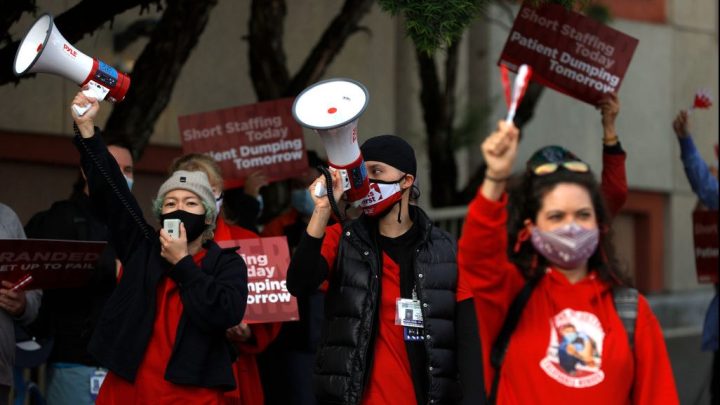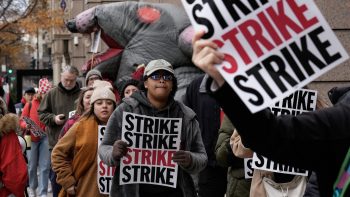
How big a year for the labor movement was 2021?

There’s been a flurry of labor activity since the start of the pandemic, ranging from the unionization of more than 200 Google employees to the now-ended strike at John Deere involving some 10,000 workers, which was the first major agriculture strike in three decades. But how widespread was labor activity in the last year?
That’s a question the Labor Action Tracker from Cornell University is designed to answer. The tool was created to map all the strikes and labor protests that occur in the country. It was launched at the end of last year, making 2021 the first full year for which it has compiled data.
“Marketplace” host Amy Scott spoke with Johnnie Kallas, the director of the Labor Action Tracker and a doctoral student at Cornell’s ILR School. The following is an edited transcript of their conversation.
Amy Scott: So, why did we need this tracker? What sets it apart from existing resources?
Johnnie Kallas: Yeah, that’s a really good question. So we started this project because there are considerable limitations with existing data sources when it comes to documenting strike activity. So, for example, the Bureau of Labor Statistics has only documented strikes involving 1,000 or more employees that last an entire shift. So you can imagine this leaves out the vast majority of strike activity. So, because of that, we decided to take on this project to try and create a more accurate database.

Scott: I’ve got the tracker open, and there’s a map of the United States with little circles showing a lot of activity in places you might suspect: the Northeast, the Midwest, the West Coast. But there are kind of holes in the country where there isn’t a lot of activity. What do you think that says about the labor movement in the United States?
Kallas: Yeah, I think that’s a really good question, and one thing we want to do is obviously show that geographic distribution. I do think that union membership is often concentrated in certain parts of the country, such as the Northeast, Midwest and West Coast, where you may see increased strike activity. That being said, we’ve also documented a fair amount of labor activism in the South and in places where maybe there isn’t as much of a historical union presence.
Scott: So I want to zoom in on one here. There’s a single event in the state of Utah, at Redstone 8 Cinemas — Metropolitan Theatres, and they were just eight workers. This was not a union strike. And it looks like they were striking for a $15 [an hour] minimum wage. Tell us about, you know, where this information comes from and what the resolution was.
Kallas: So this is one of the only — maybe the only — strike we’ve documented in Utah so far in 2021. And it was really interesting because, as you said, it’s a nonunion strike involving eight workers, but it lasted two weeks. We track information related to the employers. We also track industry and also the demands, which, as you said, were related to pay and a $15 minimum wage. I believe what happened in this situation is the workers didn’t achieve the $15 minimum wage, but they did get a $2-an-hour wage increase. And it demonstrates that even workers who don’t belong to a union have been engaging in this sort of labor activism.
Scott: And I was pleased to see your source for that data was KPCW, the local public radio station.
Kallas: Yeah, of course. And we like to place our sources on the maps. So we have certain verification protocols, so for the most part, we try and list at least two, if not more, sources that demonstrate that both the strike or the protests happened. And everything that you see on our map comes from those public sources. That’s where we generate all our information from.
Scott: If you look at the map and the numbers, you’ve tracked over 300 strikes this year, if I’m reading it correctly, compared to the BLS, which has, I think, just 13 work stoppages that’s involving more than 1,000 workers. Why do you think it’s important to see activity on a smaller scale?
Kallas: So we actually list the number of strike locations, which is slightly higher than the number of strikes. So for example, you could have a single strike, like, at John Deere at multiple locations, but as you said, it’s a huge difference with what the BLS has tracked. So for example, there has been an ongoing strike by over 700 nurses at Saint Vincent Hospital in Worcester, Massachusetts, since March 8 of this year. So that’s a strike involving over 700 nurses during a global pandemic. That’s really significant, but it’s not captured at all in the BLS data.
There’s a lot happening in the world. Through it all, Marketplace is here for you.
You rely on Marketplace to break down the world’s events and tell you how it affects you in a fact-based, approachable way. We rely on your financial support to keep making that possible.
Your donation today powers the independent journalism that you rely on. For just $5/month, you can help sustain Marketplace so we can keep reporting on the things that matter to you.

















